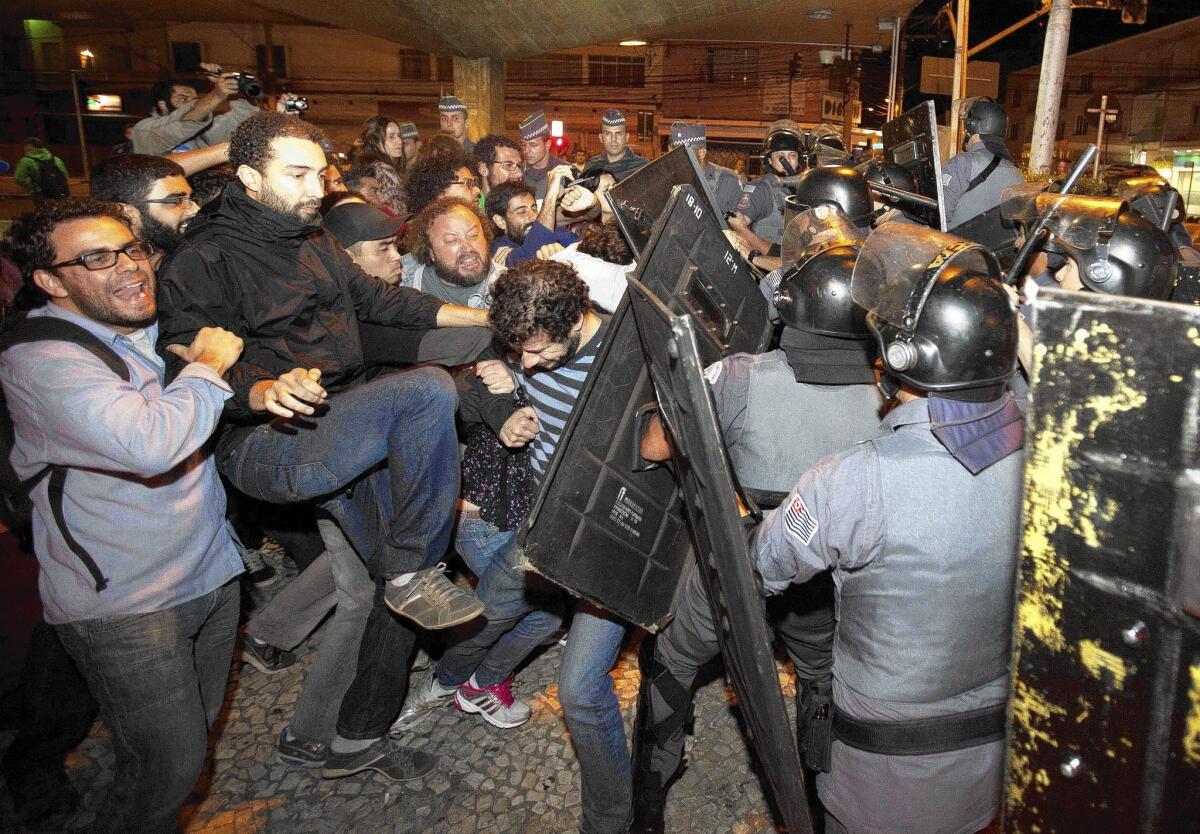Opinion: Brazil’s ‘1984’-style World Cup security may be coming to your city too

The World Cup in Brazil ended the way it started, with authorities flexing unprecedented muscle to squelch dissenters, silence journalists and shield the carefully manicured event from disruption.
President Dilma Rousseff promised to host “the Cup of Cups,” and her government spent more than $850 million on security — five times what was spent in South Africa in 2010 — to ensure its month in the spotlight would not be tainted by civil unrest. All told, the country deployed 100,000 public safety officials and 50,000 military personnel who used drones, mobile integrated surveillance units, facial recognition technology and good ol’ fashioned riot gear to maintain law and order.
Authorities clamped down in the days before the tournament, arresting several high-profile activists and citizen journalists in surprise raids. As the opening game played out in Sao Paulo, demonstrators clashed with police in Brazil’s largest cities, but the government redoubled its efforts to avoid more embarrassing scenes.
On the opening day of play in Belo Horizonte, I watched hundreds of police seal off a small anti-World Cup rally in the city’s historic center. The number of protesters paled in comparison to last year’s Confederations Cup, but many believe the overwhelming police force had a chilling effect on demonstrations.
“There are a lot of people who don’t come out here because they’re afraid,” said Rodrigo Leparoi Chaves, who works at a bakery by day to support his studies at a nearby university. “But the feelings here in the plaza are more true to Brazil than what’s happening at the stadium right now.”
An electric group stage of the tournament drowned out the protests, and soon people were calling Brazil’s tournament the best World Cup in recent memory. As nationalist fever swept the country, Brazilians seized the spotlight to show the world that their homeland is bigger, bolder and more complex than soccer and samba. But all the while, authorities were testing new technologies, pushing the limits of their power and establishing a security legacy that will last for years to come.
In Rio de Janeiro, military troops undertook 24/7 patrols in one of the city’s largest low-income neighborhoods as part of pacification efforts that will continue after the World Cup. Across the country, thousands of newly installed security cameras fed live footage to a massive video wall at the Center for International Cooperation of the Brazilian Federal Police in Brasilia, where 200 intelligence staff from 36 countries, the United Nations, Interpol and Ameripol feasted on the surveillance data.
Yet no amount of security could mask the deep fissures exposed during the World Cup. Matches were largely attended by white elites, in sharp contrast to the majority of Brazil’s population. An accident in Manaus left hundreds of thousands of residents without water service. An overpass just two miles from the stadium in Belo Horizonte collapsed, killing two. Heavy rainfall in Natal caused mudslides and forced evacuations. And on the field, Brazil’s stunning loss to Germany left many fans scrambling to hit the reset button on the national soccer program.
By the end of the tournament, the government seemed determined to focus on factors within its control. The night before the final match, police arrested 17 activists and journalists on “temporary prison orders” to investigate them for armed gang formation. On match day, authorities doubled the security street forces to nearly 26,000 officers who patrolled roads, subway stations and other strategic points in the city. At a small demonstration near the stadium, police clashed with protesters and journalists, seizing cameras and injuring at least 11 journalists.
General José Carlos de Nardi, Brazil’s chief of the Joint Staff of the Armed Forces, said these integrated security measures were “one of the benefits that the Brazilian people will enjoy when the Cup is over.” Looking ahead, any sports event attended by more than 3,000 people will demand security officers specialized in major events, and the new mobile surveillance and command centers will function in 14 states.
At first glance, this “1984”-style security and surveillance may seem like a temporary overreach for the World Cup and the impending Olympics, yet these mega-events often serve as blueprints for security measures in public spaces, allowing governments to field-test new levels of police militarization and encroachment on privacy.
Brazil’s $850-million investment bought peace of mind for many World Cup visitors, suggesting that similar security measures may be coming to a city near you.
“I feel safer here than in Chicago,” said Mark Weber, an IT manager from Chicago I met in Manaus during the U.S.-Portugal match. “I’d like to see this many police in the streets.”
Chris Feliciano Arnold is a recipient of a 2014 Literature Fellowship from the National Endowment of the Arts. He has written essays and journalism for the Atlantic, Salon, the Millions, the Rumpus and Los Angeles Review of Books. Follow him on Twitter @chrisarnold.
Follow the Opinion section on Twitter @latimesopinion
More to Read
A cure for the common opinion
Get thought-provoking perspectives with our weekly newsletter.
You may occasionally receive promotional content from the Los Angeles Times.





